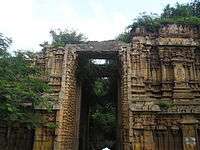Alagar Koyil
Alagar kovil is a village in Madurai district in the South Indian state of Tamil Nadu. The history and living of the village is centered around Kallazhagar Temple. Constructed in the Dravidian style of architecture, the temple is glorified in the Divya Prabandha, the early medieval Tamil canon of the Azhwar saints from the 6th–9th centuries AD. It is one of the 108 Divyadesam dedicated to Vishnu, who is worshiped as Kallazhagar and his consort Lakshmi as Thirumamagal.[1]
Azhagar Kovil | |
|---|---|
village | |
| Coordinates: 10.074136°N 78.214356°E | |
| Country | |
| State | Tamil Nadu |
| District | Madurai |
| Languages | |
| • Official | Tamil |
| Time zone | UTC+5:30 (IST) |
Temple

Kallazhagar temple covers an area of about 2 acres (0.81 hectares) and has a five-tiered gopuram (gateway tower). The temple in enclosed in a rectangular enclosure with huge granite walls. The central shrine houses the image of the presiding deity, Sundarabahu Perumal in standing posture. The images of Sridevi and Bhudevi are also housed in the sanctum. There two life size images of Narasimha, the avatar of Vishnu. One of them is shown holding the demon Hiranya and other slaying him.[2]
The temple houses some rare Vijayanagara sculptures similar to the ones present in Soundararajaperumal Temple, Thadikombu, Krishnapuram Venkatachalapathy temple, Srivilliputhur Divya Desam and Jalakandeswarar Temple, Vellore.[3]
Chithirai Festival
Chithirai festival of this temple celebrated for ten days is one of the declared festivals of Tamilnadu Government. This festival day is declared as Local Holiday. In Chithirai (April-May), Lord Kallalagar starts from Alagar kovil in the form of Kallar and reaches Madurai on Pournami (Full Moon day). Here he steps into river Vaigai in his Horse Vaganam. Lakhs of devotees flock to river Vaigai to see this event. "Ethir Sevai" festival is celebrated on the day before Alagar steps into river Vaigai. It is a tradition for the people of Madurai to welcome Alagar.
As Alagar returns from Vandiyur Dhasavatharam festival is celebrated throughout the night at Ramarayar Mandapam in the Northern part of river Vaigai. After this event Alagar is taken to Mysore Veera Mandapam on decorated Anantharayar Palanquin. The next morning Alagar in the form of Kallar returns to Alagar kovil in ‘Poo Pallakku'(Palanquin decorated with flowers)
In the month of April and may, each year the great Chitra festival is celebrated on Pournami (full moon day). The Festival dramatically re enacts the visitation of Lord Kallalagar to Madurai from Alagarkoil . Lakhs of devotees flock to river Vaigai to personally witness the event of lord Alagar stepping down into the river and to get his blessings.
During the months of July and August the festival of Aadi Brahmmorchavam is being celebrated for 10 days. This festival occurs within the precincts of the shrine. Devotees from different parts of Tamilnadu throng to participate in this festival. The temple car ‘Amaiththa Narayanan’ is taken in procession during Pournami (Full-Moon day) of Aadi (Brahmotchavam).
References
- M. S., Ramesh (1993). 108 Vaishnavite Divya Desams: Divya desams in Pandya Nadu. Tirumalai-Tirupati Devasthanam.
- Rao, A.V.Shankaranarayana (2012). Temples of Tamil Nadu. Vasan Publications. p. 229–31. ISBN 978-81-8468-112-3.
- S., Gopalakrishnan (December 1996). "The Raṅga-maṇḍapa of the Tāṭikkompu Temple A Study of an Iconographic Programme of the Vijayanagara Tradition". East and West. 46 (3/4): 415–431. JSTOR 29757285.